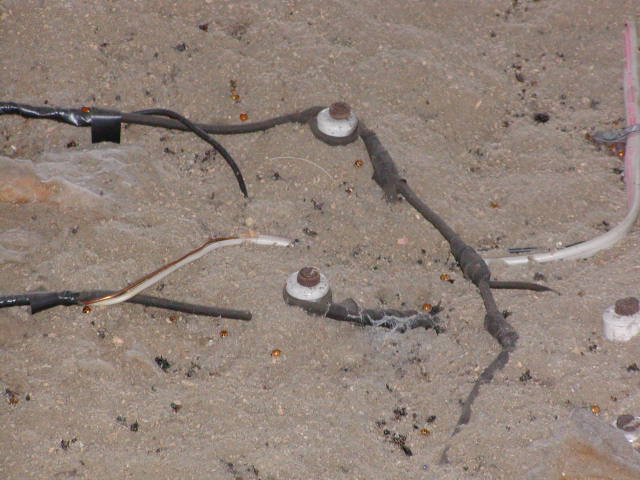Knob and Tube Wiring
Knob-and-tube (K&T) wiring was an early standardized method of electrical wiring in buildings, in common use in North America from about 1880 to the 1940s. The system is considered obsolete and can be a safety hazard.
Home inspectors should always report knob-and-tube wiring during their inspections as a safety hazard, and advise replacement.
Facts About Knob-and-Tube Wiring:
- It is not inherently dangerous. The dangers from this system arise from its age, improper modifications, and situations where building insulation envelops the wires.
- It has no ground wire and thus cannot service any three-pronged appliances.
- While it is considered obsolete, there is no code that requires its complete removal.
- It is treated differently in different jurisdictions. In some areas, it must be removed at all accessible locations, while others merely require that it not be installed in new construction. Inspectors should be sure to know the codes in the jurisdictions in which they operate.
- It is not permitted in any new construction.
- K&T wiring has a higher ampacity than wiring systems of the same gauge. The reason for this is that the hot and neutral wires are separated from one another, usually by 4 to 6 inches, which allows the wires to readily dissipate heat into free air.
- K&T wires are less likely than Romex cables to be punctured by nails because K&T wires are held away from the framing.
- The porcelain components have an almost unlimited lifespan.
- The original installation of knob-and-tube wiring is often superior to that of modern Romex wiring. K&T wiring installation requires more skill to install than Romex and, for this reason, unskilled people rarely ever installed it.
- Unsafe modifications are far more common with K&T wiring than they are with Romex and other modern wiring systems. Part of the reason for this is that K&T is so old that more opportunity has existed for improper modifications.
- The insulation that envelopes the wiring is a fire hazard.
- It tends to stretch and sag over time.
- It lacks a grounding conductor. Grounding conductors reduce the chance of electrical fire and damage to sensitive equipment.
- In older systems, wiring is insulated with varnish and fiber materials that are susceptible to deterioration.
- A licensed electrical contractor must certify that the system is safe.
- The certification must be filed with the local building department.
- Accessible areas where insulation covers the wiring must be posted with a warning sign. In some areas, this sign must be in Spanish and English.
- The insulation must be non-combustible and non-conductive.
- Normal requirements for insulation must be met.

When K&T wiring was first introduced, common household electrical appliances were limited to little more than toasters, tea kettles, coffee percolators and
clothes irons. The electrical requirements of mid- to late-20th century homes
could not have been foreseen during the late 18th century, a time during which electricity, to many, was seen as a passing fad. Existing K&T systems are notorious for modifications made in an attempt to match the increasing amperage loads required by televisions, refrigerators, and a plethora of other electric appliances. Many of these attempts were made by insufficiently trained handymen, rather than experienced electricians, whose work made the wiring system vulnerable to overloading.
- Many homeowners adapted to the inadequate amperage of K&T wiring by installing fuses with resistances that were too high for the wiring. The result of this modification is that the fuses would not blow as often and the wiring would suffer heat damage due to excessive amperage loads.
- It is not uncommon for inspectors to find connections wrapped with masking tape or Scotch tape instead of electrical tape.
- Have the system evaluated by a qualified electrician. Only an expert can confirm that the system was installed and modified correctly.
- Do not run an excessive amount of appliances in the home, as this can cause a fire.
- Where the wiring is brittle or cracked, it should be replaced. Proper maintenance is crucial.
- K&T wiring should not be used in kitchens, bathrooms, laundry rooms or outdoors. Wiring must be grounded in order to be used safely in these locations.
- Rewiring a house can take weeks and cost thousands of dollars, but unsafe wiring can cause fires, complicate estate transactions, and make insurers skittish.
- Homeowners should carefully consider their options before deciding whether to rewire their house.
- The homeowner or an electrician should carefully remove any insulation that is found surrounding K&T wires.
- Prospective home buyers should get an estimate of the cost of replacing K&T wiring. They can use this amount to negotiate a cheaper price for the house.
Philippe Heller is the President of The San Diego Real Estate Inspection Co.



